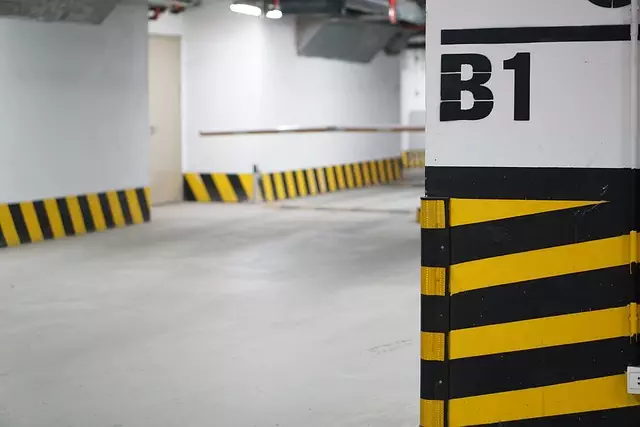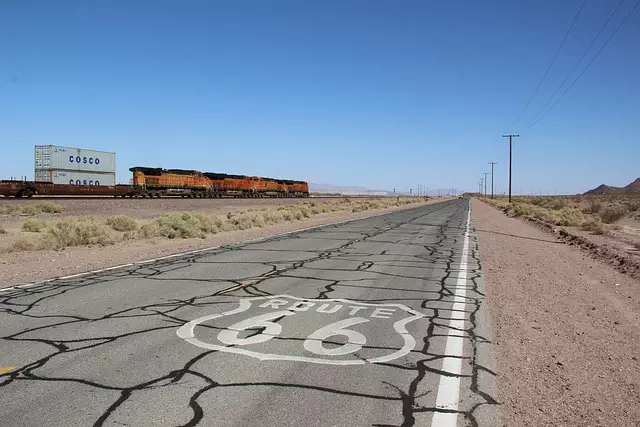The environmental impact of asphalt parking lot construction in Toledo, Ohio, is significant, with traditional methods leading to high energy consumption and greenhouse gas emissions. The city's approach addresses these issues by promoting sustainable practices such as using recycled asphalt pavement (RAP) and warm mix asphalt (WMA), which reduce energy use and emissions while maintaining the durability of the parking lots. Innovative designs that incorporate permeable pavements, reflective roof pigments, and eco-friendly drainage systems are being implemented to manage stormwater effectively, mitigate urban heat island effects, and protect local waterways from pollution. Toledo's commitment to integrating green technologies in asphalt parking lot construction sets a precedent for sustainable infrastructure development, emphasizing the importance of responsible material choices and environmentally conscious practices to minimize ecological footprints and promote biodiversity. The city's initiatives underscore the need for ongoing monitoring and maintenance to ensure the long-term sustainability of these projects, making Toledo a model for other regions in the realm of eco-friendly asphalt parking lot construction.
Asphalt parking lot construction presents a multifaceted environmental challenge, particularly in urban settings like Toledo, Ohio. This article delves into the ecological footprint of such projects, scrutinizing their impact from material selection to stormwater runoff management and beyond. We explore the sustainability practices within asphalt parking lot construction, the energy consumption and greenhouse gas emissions associated with these developments, and the long-term environmental effects they entail. Through a comprehensive analysis of Toledo’s asphalt parking lot construction, this article aims to highlight strategies for mitigating adverse impacts and promoting greener, more sustainable practices in the field.
- Assessing the Ecological Footprint of Toledo Ohio Asphalt Parking Lot Construction
- Material Selection and Sustainability in Asphalt Parking Lot Projects
- Impact of Stormwater Runoff from Asphalt Parking Lots in Toledo, Ohio
- Energy Consumption and Greenhouse Gas Emissions During Asphalt Parking Lot Construction
- Post-Construction Management: Mitigating Long-Term Environmental Effects of Asphalt Parkings in Toledo
Assessing the Ecological Footprint of Toledo Ohio Asphalt Parking Lot Construction

In assessing the ecological footprint of asphalt parking lot construction in Toledo, Ohio, it is imperative to consider the various environmental impacts associated with this urban development. The process begins with the clearing of vegetation and soil disruption, which can lead to erosion and loss of biodiversity on-site. The excavation and transportation of materials for the asphalt mix contribute to carbon emissions, a significant aspect of the project’s overall environmental impact. Furthermore, the runoff from construction sites often carries pollutants into local waterways, potentially affecting aquatic ecosystems and contributing to water quality issues.
Once constructed, an asphalt parking lot in Toledo, Ohio, presents a durable but impervious surface that can hinder natural water absorption and alter local hydrology. The reflective heat island effect of dark asphalt surfaces contributes to urban heating, influencing microclimates and increasing energy demands for cooling in the surrounding area. Additionally, the lifecycle of an asphalt parking lot involves ongoing maintenance, which may include seal coating with petroleum-based products, potentially releasing volatile organic compounds (VOCs) into the atmosphere. It is through careful planning, innovative construction techniques, and the implementation of green infrastructure that the environmental consequences of Toledo’s asphalt parking lot construction can be mitigated and managed responsibly.
Material Selection and Sustainability in Asphalt Parking Lot Projects

In recent years, the construction of asphalt parking lots has garnered increased scrutiny regarding their environmental impact. Sustainable practices in asphalt parking lot construction are becoming more integral to mitigate this influence. Material selection is a critical factor in achieving sustainability within these projects. Contractors and engineers in Toledo, Ohio, and beyond are now opting for recycled asphalt pavement (RAP) and warm mix asphalt (WMA) technologies, which reduce energy consumption and greenhouse gas emissions during the construction process. These materials not only decrease the environmental footprint but also offer cost-effectiveness and durability comparable to traditional asphalt.
Furthermore, the integration of permeable pavements and reflective roof pigments in asphalt parking lot construction can significantly enhance water management and reduce urban heat island effects. In Toledo, Ohio, where environmental stewardship is increasingly prioritized, such innovative solutions are not only commendable but also a step towards more sustainable infrastructure. The city’s commitment to incorporating green technologies in its asphalt parking lot construction projects sets a precedent for other regions to follow, underscoring the importance of responsible material selection and forward-thinking sustainability practices in the industry.
Impact of Stormwater Runoff from Asphalt Parking Lots in Toledo, Ohio

In Toledo, Ohio, the prevalence of asphalt parking lot construction has significant implications for local waterways due to stormwater runoff. These impervious surfaces accelerate the flow of rainwater, which can lead to increased erosion and sedimentation in nearby rivers and lakes. The rapid runoff also conveys a variety of pollutants into these aquatic systems, including oils, heavy metals, and debris from vehicle maintenance activities. This can result in water quality degradation, affecting not only the ecosystem but also municipal drinking water sources and recreational areas. To mitigate these impacts, sustainable drainage practices are being integrated into asphalt parking lot construction in Toledo. These include the implementation of permeable pavements, rain gardens, and bioswales that help filter and absorb stormwater runoff before it reaches the public sewer or water bodies. Such measures not only protect the environment but also contribute to long-term cost savings by reducing the need for expensive infrastructure upgrades to manage increased runoff volumes. The commitment to eco-friendly asphalt parking lot construction in Toledo underscores the importance of considering environmental stewardship in urban development projects.
Energy Consumption and Greenhouse Gas Emissions During Asphalt Parking Lot Construction

The construction of asphalt parking lots, including those in Toledo, Ohio, entails significant energy consumption and contributes to greenhouse gas emissions. The process begins with the extraction of crude oil or natural gas, which are refined into various hydrocarbons to produce the asphalt mixture. This extraction and refinement phase already demand substantial energy inputs and result in carbon dioxide (CO2) emissions. Furthermore, the actual construction process involves the use of heavy machinery such as pavers, rollers, and trucks for transportation of materials, all of which run on diesel or gasoline, adding to the carbon footprint. The production of these machines and their operation further contribute to the emission of nitrous oxides (NOx) and volatile organic compounds (VOCs), which are potent greenhouse gases.
Additionally, the asphalt production process itself consumes a considerable amount of energy. Asphalt mix plants, where the hot mix is prepared, require significant amounts of fuel to maintain high temperatures necessary for the bitumen to bind effectively with aggregate. The environmental impact of these emissions is a growing concern, prompting researchers and construction companies in Toledo, Ohio, and beyond to explore alternative materials and methods that could reduce the carbon footprint associated with asphalt parking lot construction. Innovations such as warm mix asphalt technology, which reduces the energy required and thus the emissions produced, are being adopted to mitigate some of these impacts. These advancements highlight the importance of considering sustainable practices in the construction industry to lessen the environmental burden.
Post-Construction Management: Mitigating Long-Term Environmental Effects of Asphalt Parkings in Toledo

Asphalt parking lot construction in Toledo, Ohio, presents both opportunities for and challenges to sustainable development. Post-construction management is a critical phase that addresses the long-term environmental effects of these projects. Effective management strategies post-construction are essential to mitigate the potential negative impacts associated with runoff, habitat disruption, and urban heat island effects. In Toledo, the unique geographical and climatic conditions necessitate tailored solutions to manage stormwater runoff, which can carry pollutants into nearby water bodies, compromising local ecosystems. Implementing permeable pavements, rain gardens, and proper drainage systems within asphalt parking lot construction projects can significantly reduce the volume of runoff and improve water quality. Moreover, selecting materials that are recycled or derived from sustainable sources can lessen the environmental footprint of these constructions.
The use of reflective pavements and vegetative cover in Toledo’s asphalt parking lot construction not only aids in reducing the urban heat island effect but also contributes to the enhancement of biodiversity by preserving green spaces and providing habitats for local wildlife. Continuous monitoring and maintenance are vital to ensure these measures remain effective over time. By adopting such forward-thinking approaches, Toledo can lead the way in minimizing the environmental impact of asphalt parking lot construction while maintaining functionality and safety for its residents and commuters.


